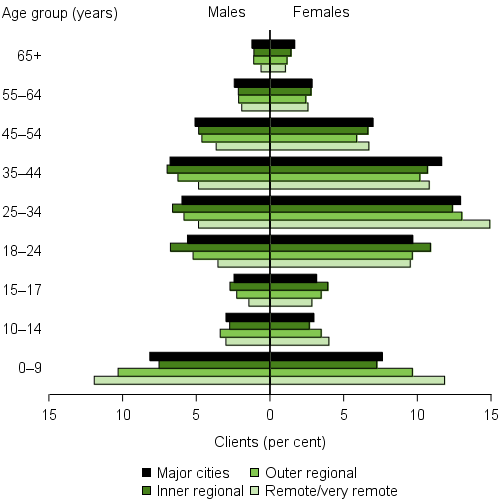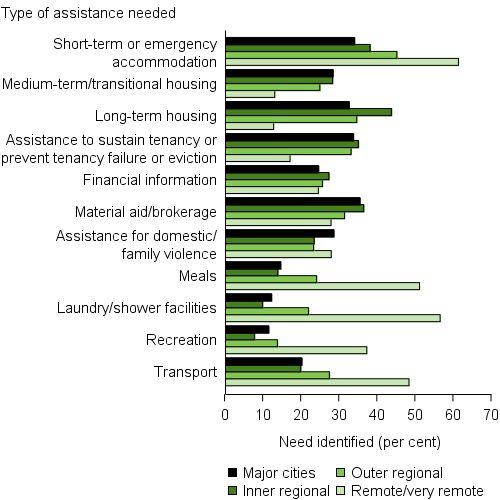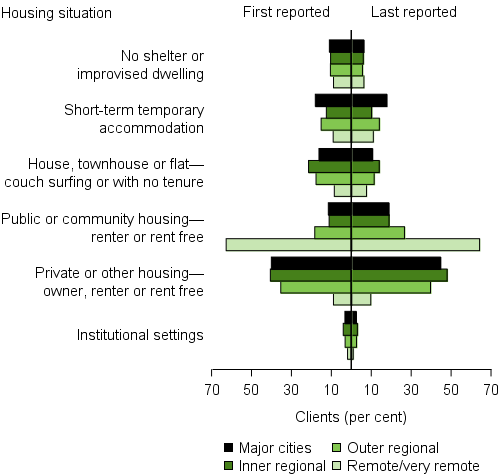Clients in regional and remote areas
Key findings in 2015–16
- Client numbers increased in all regional areas in 2015–16 but by the greatest percentage increase in Inner regional areas.
- Indigenous client numbers in all regional areas increased at faster rates than non-Indigenous clients, with Inner regional areas (Indigenous 26% compared with non-Indigenous 14%) and Major cities (18% compared with 8%) experiencing the highest growth in Indigenous clients compared with 2014–15.
- The housing situation of clients when seeking assistance was very different across regional areas, with most clients (73%) in Remote/Very remote areas housed, but living in unstable situations (at risk of homelessness), compared with clients in all other regional areas (55–57% at risk).
- The rate of service use continued to be highest in Remote/Very remote areas, increasing to 1 in 38 people compared with 1 in 41 in 2014–15.
- Remote/Very remote areas had higher proportions of families presenting with children compared with Major cities while the proportion of lone persons was higher in Major cities.
Clients by geographic area: trends over time
1 in 38 people living in Remote/Very remote areas
were supported by homelessness agencies in 2015–16; the rate of service use in these areas is the fastest growing, at 6% on average each year between 2011–12 and 2015–16.
Since the beginning of the specialist homelessness services collection in 2011–12, there has been a steady increase in the number of clients across most geographic areas. The collection continues to reveal differences in client characteristics and service needs across these areas. Some key regional trends over the 5 years since the collection began have been:
- Taking into account population differences, Remote/Very remote areas consistently reported the highest rate of homelessness service use (Table Regional Trends.1). These areas also showed the largest growth in the rate of service use, increasing by an average of 6.0% each year since 2011–12.
- The proportion of Indigenous clients in both the Outer regional and Remote/Very remote areas has increased each year; in 2015–16, almost half (48%) and 9 in 10 (90%) clients identified as Indigenous in these areas, respectively.
- Domestic and family violence has remained the main reason clients sought assistance in all regional areas until 2015–16 when housing crisis was reported by slightly more clients in Inner regional areas (23%) than domestic and family violence (22%).
| Year | Major cities | Inner regional | Outer regional | Remote/ Very remote | |
|---|---|---|---|---|---|
| Number of clients (proportion (per cent) of all clients) | |||||
| 2015–16 | 174,744 (63) | 60,013 (21) | 30,790 (11) | 13,650 (5) | |
| 2014–15 | 162,286 (63) | 52,061 (20) | 28,257 (11) | 13,053 (5) | |
| 2013–14 | 159,877 (63) | 55,510 (22) | 26,785 (11) | 11,831 (5) | |
| Rate (per 10,000 population) | |||||
| 2015–16 | 103.6 | 139.5 | 147.6 | 259.9 | |
| 2014–15 | 97.7 | 122.0 | 135.7 | 245.3 | |
| 2013–14 | 98.0 | 131.7 | 139.6 | 222.4 | |
| Housing situation at the beginning of first support period (proportion (per cent) all clients) | |||||
| 2015–16 | Homeless | 45 | 43 | 43 | 27 |
| At risk of homelessness | 55 | 57 | 57 | 73 | |
| 2014–15 | Homeless | 45 | 41 | 43 | 29 |
| At risk of homelessness | 55 | 59 | 57 | 71 | |
| 2013–14 | Homeless | 42 | 41 | 46 | 34 |
| At risk of homelessness | 58 | 59 | 54 | 66 | |
| Length of support (median number of days) | |||||
| 2015–16 | 33 | 41 | 36 | 17 | |
| 2014–15 | 32 | 39 | 36 | 17 | |
| 2013–14 | 31 | 42 | 31 | 21 | |
| Average number of support periods per client | |||||
| 2015–16 | 1.7 | 1.6 | 1.5 | 1.5 | |
| 2014–15 | 1.7 | 1.5 | 1.5 | 1.5 | |
| 2013–14 | 1.6 | 1.5 | 1.5 | 1.4 | |
| Proportion receiving accommodation | |||||
| 2015–16 | 29 | 27 | 39 | 62 | |
| 2014–15 | 31 | 29 | 41 | 58 | |
| 2013–14 | 32 | 29 | 44 | 63 | |
| Median number of nights accommodated | |||||
| 2015–16 | 48 | 34 | 23 | 5 | |
| 2014–15 | 48 | 35 | 21 | 5 | |
| 2013–14 | 49 | 38 | 20 | 6 | |
| Proportion of a client group who had a case management plan (per cent) | |||||
| 2015–16 | 59 | 61 | 75 | 60 | |
| 2014–15 | 58 | 61 | 73 | 62 | |
| 2013–14 | 55 | 62 | 65 | 66 | |
| Achievement of all case management goals (per cent) | |||||
| 2015–16 | 24 | 16 | 31 | 27 | |
| 2014–15 | 27 | 18 | 30 | 29 | |
| 2013–14 | 27 | 16 | 21 | 27 | |
Notes
- Rates are crude rates based on the Australian estimated resident population (ERP) at 30 June of the reference year.
- The denominator for the proportion achieving all case management goals is the number of client groups with a case management plan. Denominator values for proportions are provided in the relevant National supplementary table.
- Previous years’ data can be found in the AIHW 2014–15 Specialist Homelessness Services annual report.
Source: Specialist Homelessness Services Collection 2013–14 to 2015–16.
Clients in regional and remote areas
In 2015–16 regional areas displayed distinct characteristics:
- A large proportion of clients accessing specialist homelessness services lived in Major cities (63%). This is slightly lower than for the broader Australian population, 70% of whom live in Major cities (AIHW analysis of the ABS 2011 Census).
- The proportion of Indigenous clients increased as remoteness increased, similar to 2014–15; 15% lived in Major cities, 23% in Inner regional, 48% in Outer regional and 90% in Remote/Very remote areas.
- Some client groups were more likely to access specialist homelessness services in Major cities. For example, in 2015–16 67% of SHS clients with a current mental health issue and 86% of SHS clients born overseas accessed specialist homelessness services in Major cities.
- A higher proportion of clients of homelessness services in 2015–16 were located in Remote/Very remote areas (5%) compared with the general population (2%). Nine in 10 clients in Remote/Very remote areas were Indigenous (90%).
- The proportion of clients living in Remote/Very remote areas who were homeless upon presentation decreased from 29% in 2014–15 to 27% in 2015–16 and is very different to the homeless rate in other regional areas (Table Regional Trends.1).
- Accommodation length varied considerably across regional areas. In 2015–16, over half of the clients in Major cities received 48 or more nights accommodation while less than half of the clients in Remote/Very remote areas received 5 or fewer nights.
- The main reason clients sought assistance varied across regional areas; domestic and family violence and housing crisis were similarly reported as the main reason in Major cities (27%, 23%, respectively), Inner regional (22%, 23%%), and Outer regional (both reasons 24%) areas while domestic and family violence was reported by 1 in 3 (32%) clients in Remote/Very remote areas and housing crisis just 14%.
Age and sex
About 1 in 4 clients
in Remote/Very remote areas (24%) were children under the age of 10; all other regional areas had lower rates, from 15% in Inner regional, 16% in Major cities and 20% in Outer regional areas.
Clients aged 25–34
represented the largest proportion across Major cities and Inner regional areas (both 19%).
Clients aged 0–9
represented the largest proportion in both Outer regional and Remote/Very remote areas (20%, 24%, respectively).
- Across all remoteness areas, there were more females than male clients (Figure REG.1). The proportion of females increased as remoteness increased. Females represented 59% of clients in Major cities compared with 64% of clients in Remote/Very remote areas.
- Together with the younger age of clients in more remote regions these data suggest that in Remote/Very remote areas there were higher proportions of families presenting with children compared with Major cities while the proportion of lone persons was higher in Major cities.
Figure REG.1: Clients, by remoteness area and by age and sex, 2015–16

Source: Specialist Homelessness Services 2015–16, National Supplementary Table REG.1.
Services needed and provided
61%
of clients accessing agencies located in Remote/Very remote areas required short-term or emergency accommodation.
87%
of requests for accommodation were met in Remote/Very remote areas; however, the likelihood of receiving accommodation reduced with urbanisation with clients in Major cities and Inner regional areas the least likely to receive accommodation (55% and 45% of need met, respectively).
Mental health services
were needed by a higher proportion of clients living in Major cities (9%) than those in any other region (between 3% and 7%).
- Clients accessing agencies located in Remote/Very remote areas were assessed with more needs compared with clients in other areas (Figure REG.2).
- Trends for clients accessing services in Inner regional areas were generally similar to those in Major cities. However, a higher proportion of clients accessing services in Inner regional areas needed long-term housing (44% compared with 33% in Major cities).
- One in 4 (25%) clients accessing services in Remote/Very remote areas needed 'other specialist services', including health/ medical (13%), specialist counselling (5%), and other specialised services (17%). Clients in Inner regional areas were the least likely to need these services (16%).
Figure REG.2: Most needed services by remoteness area, 2015–16

Notes
- Most needed excludes 'Other basic assistance', 'Advice/information', and 'Advocacy/liaison on behalf of client'.
- Proportions have been calculated using the client count for each remoteness area as the denominator.
Source: Specialist Homelessness Services 2015–16, National Supplementary Table REG.3.
Housing outcomes
- Clients accessing services in Major cities were the least likely to report ending support in stable housing (66%), and most of these clients ended support in private or other housing as a renter, rent free or owner (45%) (Figure REG.3).
- Inner regional clients were the most likely to be housed in private or other housing at the end of their support period (48%). They were also the most likely to improve their housing situation following SHS assistance with 70% housed at the end of support, up 14 percentage points from the beginning of support.
- Those clients accessing agencies in Remote/Very remote areas were more likely to report living in public or community housing (63%) at the beginning of their support period. While these clients were the most likely to be classified as 'housed' at the end of their support period (75%) this is to some extent a reflection of their housing situation prior to SHS assistance.
Figure REG.3: Clients, by remoteness area and housing situation at beginning of support and end of support, 2015–16

Notes
- The SHSC classifies clients living with no shelter or improvised/ inadequate dwelling, short-term temporary accommodation, or in a house, townhouse, or flat with relatives (rent free) as homeless. Clients living in public or community housing (renter or rent free), private or other housing (renter or rent free), or in institutional settings are classified as housed.
- Proportions include only clients with closed support at the end of the reporting period.
Source: Specialist Homelessness Services 2015–16, National Supplementary Table REG.4.


